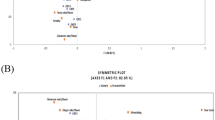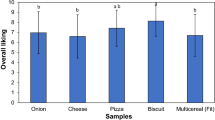Abstract
In China, herbal drinks possess long-standing traditional cultural characteristics cater to consumers’ demand for both natural ingredients and functional benefits. So far, the sensory properties of herbal beverages have not been subjected to descriptive analysis. Here, we selected 12 high-selling herbal beverages containing chrysanthemum samples on China’s largest online shopping website. A total of 11 sensory descriptors have been associated with the samples, while assessed panel performance and sensory characteristics of samples by PanelCheck software. In addition, use ConsumerCheck to investigate the consumer acceptance of the same samples, and apply preference mapping analysis to address the relationship between descriptive and consumer liking date. Box plot and Stacked histogram visualise the distributions of the liking ratings across all consumers for each of the tested products . Preference mapping revealed that the main sensory attributes driving consumers’ preferences are fragrant sweet flavour, brillancy, lubrication, sweet taste and overly sweet taste. Thus, this study could guide the development of Chinese traditional chrysanthemum drink. At the same time, the results also provided a simple and open-source software to data statistical method for practitioner without commercial software and programming skills.














Similar content being viewed by others
Data availability
All relevant data are within the paper.
References
Attila G, Dániel S, Tamás F et al (2013) Statistical possibilities of the of the Panelcheck software at monitoring of sensory panel performance. Elelmiszervizsgalati Kozlemenyek 59(1):15–27
Bae SM, Lee SC (2008) Effect of hot-air drying temperature on volatile compounds in Chrysanthemum boreale M. flowers. Korean J Food Sci Technol 40(4):466–469
Bhardwaj A, Sharma N, Sharma V et al (2022) Assessing the consumer acceptance and storability of chitosan and beeswax coated cellulose packaging for whole wheat bread. Food Control 133(Pt.B):108682
Campoceballos DA, Gavirial-López CA (2023) Optimising consumer acceptability of Cauca specialty coffee through roasting profiles on acidity and body sensory attributes. Czech J Food Sci 41(02):64–72
Dahl T, Tomic O, Wold JP et al (2008) Some new tools for visualising multi-way sensory data. Food Qual Prefer 19(1):103–113
Deng Z, Fu Z, Yan W et al (2021) The different effects of Chinese herb solid drink and lactulose on gut microbiota in rats with slow transit constipation induced by compound diphenoxylate. Food Res Int 143:110273
Faccioli LS, Klein MP, Borges GR et al (2021) Development of crackers with the addition of olive leaf flour (Olea europaea L.): Chemical and sensory characterization. LWT- Food Sci Technol 141(264):110848
Ge Z, Men L, Kai S et al (2022) Antioxidant effect of Chrysanthemum morifolium (Chuju) extract on H2O2-treated L-O2 cells as revealed by LC/MS-based metabolic profiling. Antioxidants 11(6):1068
González-Mohino A, Jiménez A, Rufo M et al (2021) Correlation analysis between acoustic and sensory technique data for cooked pork loin samples. LWT- Food Sci Technol 141:110882
Ho P (2015) Statistical methods and tools for analysing sensory food texture. Modifying Food Texture 20:45–87
Huang X, Hsieh F (2010) Physical properties, sensory attributes, and consumer preference of pear fruit leather. J Food Sci 70(3):177–186
ISO, ISO 8586. (2012) Guideline for selection, training and monitoring of selected assessors and expert sensory assessors in General guidelines for the selection, training and monitoring of selected assessors and expert sensory assessors.
ISO, ISO 8589. (2007) Sensory analysis - General guidance for the design of test rooms.
Jo Y, Kim MK (2020) Influences of appearance characteristics on consumer acceptance and perception of "gu-soo" in fermented soybean paste (doenjang). J Sens Stud 35(05):e12597
Lanza B, Amoruso F (2020) Panel performance, discrimination power of descriptors, and sensory characterization of table olive samples. J Sens Stud 35(1):e12542
Lattey KA, Bramley BR, Francis IL (2010) Consumer acceptability, sensory properties and expert quality judgements of Australian Cabernet Sauvignon and Shiraz wines. Aust J Grape Wine Res 16(1):189–202
Luo D, Chen J, Gao L et al (2017) Geographical origin identification and quality control of Chinese chrysanthemum flower teas using gas chromatography–mass spectrometry and olfactometry and electronic nose combined with principal component analysis. Int J Food Sci Technol 52(3):714–723
Martins ZE, Pinho O, Ferreira IMPLO (2017) Fortification of wheat bread with agroindustry by-products: statistical methods for sensory preference evaluation and correlation with color and crumb structure. J Food Sci 82(7-9):2183–2191
Mauricio AA, Palazzo AB, Caselato VM et al (2016) Generalized procrustes analysis and external preference map used to consumer drivers of diet gluten free product. Food Nutr Sci 7:711–723
Mudasser NM, Zameer DA, Omer N et al (2021) Variations in growth performance, meat quality and consumer preferences influenced by difference of breed in buffalo bulls. Anim Prod Sci 61(16):1715–1722
Naima HA, Mehdi S, Morched C (2013) Training and control of performance of a tactile sensory panel. J Appl Sci 13(3):366–376
Ns T, Tomic O, Endrizzi I et al (2021) Principal components analysis of descriptive sensory data: Reflections, challenges, and suggestions. J Sens Stud 36(5):12692
Pagès J, Husson F (2013) Multiple factor analysis: presentation of the method using sensory data. John Wiley & Sons, Ltd.
Peryam DR, Pilgrim FJ (1957) Hedonic scale method of measuring food preferences. Food Technol 11(9):9–14
Pineau N, Chabanet C, Schlich P (2007) Modeling the evolution of the performance of a sensory panel: a mixed-model and control chart approach. J Sens Stud 22(2):212–214
Stavros P, Oliver RA, Helen D et al (2015) Preferred reporting items for studies mapping onto preference-based outcome measures: the MAPS statement. Int J Technol Assess Health Care 31(4):230–235
Talsma P (2016) Assessing sensory panel performance using generalizability theory. Food Qual Prefer 47:3–9
Tomic O, Forde C, Delahunty C et al (2013) Performance indices in descriptive sensory analysis – a complimentary screening tool for assessor and panel performance. Food Qual Prefer 28(1):122–133
Tomic O, Luciano G, Nilsen A et al (2010) Analysing sensory panel performance in a proficiency test using the PanelCheck software. Eur Food Res Technol 230(3):497–511
Tomic O, Nilsen A, Martens M et al (2007) Visualization of sensory profiling data for performance monitoring. LWT- Food Sci Technol 40(2):262–269
Tzompa-Sosa DA, Dewettinck K, Gellynck X et al (2022) Consumer acceptance towards potato chips fried in yellow mealworm oil. Food Qual Prefer 97:104487
Ubeda C, Callejon RM, Troncoso AM et al (2017) Consumer acceptance of new strawberry vinegars by preference mapping. Int J Food Prop 20(9-12):2760–2771
US Food and Drug Administration .(2017). CFR-Code of Federal.
Xiang L, Rongxia L, Xueyu W et al (2023) Effects and mechanism of action of Chrysanthemum morifolium (Jinsi Huangju) on hyperlipidemia and non-alcoholic fatty liver disease. Eur J Med Chem 255:115391
Xiaoqin L, Xingsu Z, Xin L et al (2023) Lysine malonylation of DgnsLIPID TRANSFER PROTEIN1 at the K81 site improves cold resistance in chrysanthemum. Plant Physiol 163:114818
Yuan J, Hao LJ, Gang W et al (2015) Effects of drying methods on the phytochemicals contents and antioxidant properties of chrysanthemum flower heads harvested at two developmental stages. J Funct Foods 19:786–795
Declarations
Since the research involved tasting and food quality evaluation, the academic committee of the School of Biological and Food Engineering of Chuzhou University approved the study and exempted it from review. According to the FDA, CFR-Code of Federal Regulations Title 21-food quality and consumer acceptance studies are exempted from review (US Food and Drug Administration 2017).
Conflict of Interest
Long Men declares no conflict of interest. Liang Bin declares no conflict of interest. Li Linlin declares no conflict of interest. Yang Jie declares no conflict of interest. Chai Wenli declares no conflict of interest. Ge Rui declares no conflict of interest. Zhou Di declares no conflict of interest. Zhan Ge declares no conflict of interest.
Funding
This work was supported by Anhui Education Department (2022AH051120, 2023AH051623) and CHUZHOU University (2022XYJB31, 2020jyz027, 2022ghjc07, 2022hqkc001, 2022zsxm007, 2023zckc007).
Author information
Authors and Affiliations
Contributions
L. M.: conceptualization, methodology, software, experiment, data analysis, writing-original draft. L. B.: methodology, software, experiment, data analysis. L. L.: methodology, experiment. Y. J.: experiment. C. W.: experiment. G. R.: experiment. Z. D.: experiment. Z. G.: conceptualization, funding acquisition, resources, supervision, writing-review and editing.
Corresponding author
Additional information
Publisher’s Note
Springer Nature remains neutral with regard to jurisdictional claims in published maps and institutional affiliations.
Rights and permissions
Springer Nature or its licensor (e.g. a society or other partner) holds exclusive rights to this article under a publishing agreement with the author(s) or other rightsholder(s); author self-archiving of the accepted manuscript version of this article is solely governed by the terms of such publishing agreement and applicable law.
About this article
Cite this article
Men, L., Bin, L., Linlin, L. et al. Panel Performance, Sensory Characterization and Consumer Preference of Chinese Traditional Chrysanthemum Drink. Food Anal. Methods 17, 129–144 (2024). https://doi.org/10.1007/s12161-023-02554-w
Received:
Accepted:
Published:
Issue Date:
DOI: https://doi.org/10.1007/s12161-023-02554-w




